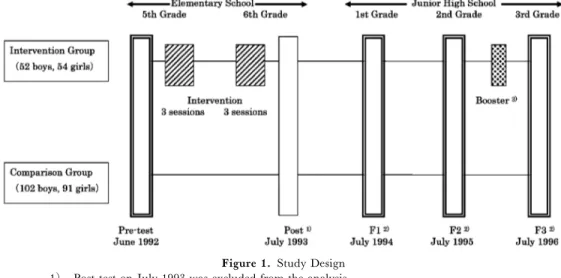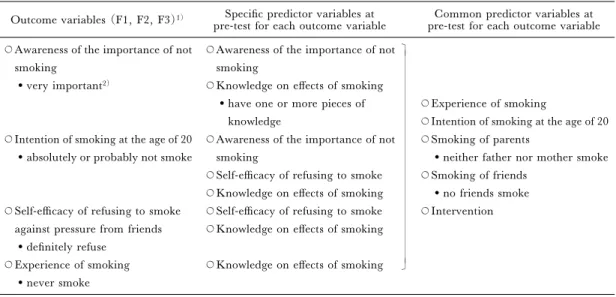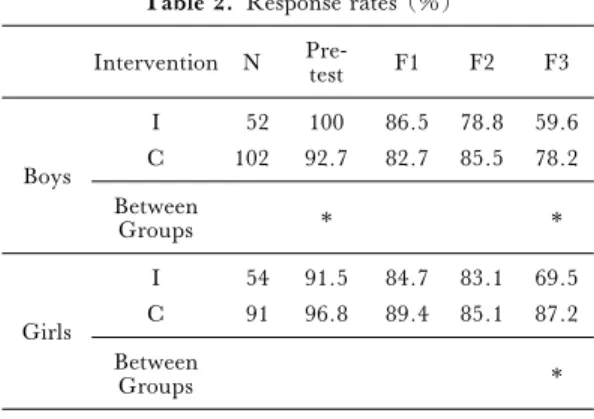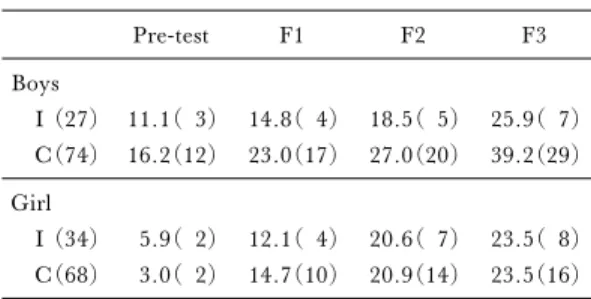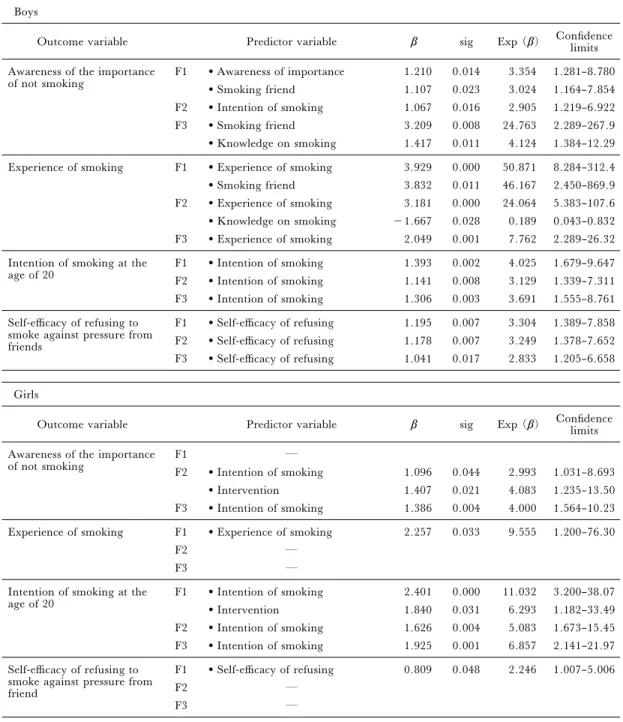1* Graduate School of Education, Hyogo University of Teacher Education
942–1 Shimokume, Yashiro-cho, Katoh-gun, Hyogo Prefecture 673–1494, Japan
E-mail: nobnishi@life.hyogo-u.ac.jp
2 Graduate School of Cultural Studies and Human Science, Kobe University
3 Faculty of Education and Human Sciences, Niigata University
4 Department of Health Promotion and Education, Osaka Medical Center for Health Science and Promo-tion
5 Department of Cancer Control and Statistics, Osaka Medical Center for Cancer and Cardiovascular Dis-eases
6 School of Nursing, Asahikawa Medical College
THREE-YEAR FOLLOW-UP ON THE EFFECTS OF A SMOKING
PREVENTION PROGRAM FOR ELEMENTARY SCHOOL
CHILDREN WITH A QUASI-EXPERIMENTAL DESIGN IN JAPAN
Nobuki NISHIOKA1*, Tetsuro KAWABATA2, Ko-hei MINAGAWA3, Masakazu NAKAMURA4, Akira OHSHIMA5, and Yoshikatsu MOCHIZUKI6
Objective We performed the follow-up tests for three years for junior high school students by the
quasi-experimental design to investigate the medium-term eŠect of smoking prevention education in the elementary school.
Methods The intervention group consisted of 106 school students of three elementary schools and
received a smoking prevention program in the elementary school. Moreover, the follow-up tests were conducted at each grade of junior high school, and the booster program was mailed. The comparison group consisted of 193 school students of another three elementary schools without the program.
Results The intervention eŠects were recognized on knowledge up to the second grade of junior
high school for boys and up to the third grade for girls, on awareness of the importance of not smoking at the second grade, and on the intention of smoking at the age of 20 for girls up to the ˆrst grade. On the other hand, the intervention eŠects were not recognized on smoking experience for boys and girls. However, increase of the rate of smoking experience was not signiˆcant in the intervention group, while it was signiˆcant in the comparison group.
Conclusion The eŠect of the program for three years was judged to be moderate.
Key words:smoking prevention education, quasi-experimental design, follow-up studies, three-years
I. Introduction
As smoking poses one of the greatest health threats to young people in Japan, prevention is receiving emphasis in the national curriculum.
Thus, children in Japan are scheduled to receive smoking prevention education at all stages, including elementary school, junior high school, and senior high school. Moreover, the Ministry of Education, Culture, Sports, Science and Technology has devel-oped brochures for children and teaching manuals for school teachers for smoking prevention educa-tion, and distributed them to schools across the
country1).
However, these measures have shown no marked eŠect. For example, the rates of current smokers at the ages of 14–15, and 17–18 were found in one study to be 10% and 27% for boys, and 4% and 11% for girls, although smoking under the age of 20 is prohibited by law. The rates of ever smokers of the same ages were 45% and 54% for boys, and
27% and 30% for girls, respectively2). Thus, it is
necessary to improve smoking prevention education
and continually evaluate eŠectiveness3), particularly
with follow-ups of over one year, which have been
lacking except in high school students4,5). Recently,
smok-Figure 1. Study Design 1) Post-test on July 1993 was excluded from the analysis.
2) F1, F2 and F3 show the ˆrst, the second and third follow-up tests, respectively.
3) A self-learning booklet was mailed to each student of the intervention group as a booster. ing prevention is emphasized but eŠective
coordina-tion with health educacoordina-tion is necessary. Verifying a medium-term eŠect of smoking prevention education would contribute a great deal.
We earlier performed an intervention study of ˆfth and sixth graders of elementary schools with a quasi-experimental design to evaluate the short and medium term eŠects of a smoking prevention pro-gram in Japan. As a short-term eŠect of the interven-tion, acquired knowledge on the acute in‰uence of smoking was remarkably increased and enhance-ment of the awareness of the importance of not smok-ing was signiˆcant. However, the intervention eŠect on smoking behavior was not clear due to the low
rate of smoking in this age group6,7).
As the next step, medium-term eŠects of the in-tervention were examined with the same subjects in junior high schools. That is, follow-up tests were per-formed by the mailing method three years after the intervention in the elementary school had been com-pleted.
II. Methods
Subject
One intervention school and one comparison school were chosen from each of three cities in Niiga-ta prefecture. The sampling of schools was not ran-dom. The intervention group, consisting of 106 school students (52 boys and 54 girls) at three elementary schools, received a smoking prevention program of three sessions in June and July of 1992 for the ˆfth graders and three sessions in June and October of 1993 for the sixth graders (Figure 1).
In developing the program, we referred to the conclusions of a National Cancer Institute-convened
Expert Advisory Panel8)and the Know Your Body
Program9) that showed the eŠects on smoking
prevention. Thus, the program focused on short-term in‰uences and psycho-social factors involved in starting smoking, and on training to resist advertise-ments and peer group pressure. The content of the program for ˆfth graders included: 1) lifestyles that in‰uence health; 2) short-term physiological eŠects of smoking; 3) factors behind starting smoking and dependence on smoking. For sixth graders were in-cluded: 1) review of the lessons for ˆfth graders and short-term physiological eŠects of smoking; 2) analy-sis of tricks used in advertising of cigarettes; 3) train-ing in assertive communication skills to resist peer pressure.
Moreover, pre-test, post-test and follow-up tests were executed, and the self-learning booklet as a booster program was mailed at the second grade of junior high school.
The comparison group consisted of 193 school students (102 boys and 91 girls) from another three elementary schools in the same three cities. The pre-, post- and follow-up tests were performed at the same time as the intervention group but without the preceding smoking prevention and booster pro-grams.
Data collection and measures
The study was conducted with a quasi-ex-perimental design where the intervention and com-parison groups recruited from diŠerent schools. The data for each child over the test period of ˆve years was assigned to an ID number although all the tests
Table 1. Outcome and predictor variables in the logistic regression analysis Outcome variables (F1, F2, F3)1) Speciˆc predictor variables at
pre-test for each outcome variable pre-test for each outcome variableCommon predictor variables at Awareness of the importance of not
smoking
very important2)
Awareness of the importance of not smoking
Knowledge on eŠects of smoking have one or more pieces of
knowledge
Experience of smoking
Intention of smoking at the age of 20 Smoking of parents
neither father nor mother smoke Smoking of friends
no friends smoke Intervention Intention of smoking at the age of 20
absolutely or probably not smoke
Awareness of the importance of not smoking
Self-e‹cacy of refusing to smoke Knowledge on eŠects of smoking Self-e‹cacy of refusing to smoke
against pressure from friends deˆnitely refuse
Self-e‹cacy of refusing to smoke Knowledge on eŠects of smoking Experience of smoking
never smoke
Knowledge on eŠects of smoking
1)F1, F2 and F3 are the ˆrst, second and third follow-up tests, respectively. 2)The reference category of the variable is shown after the black spot. were conducted anonymously.
The following measures concerning research ethics were undertaken in addition to ensuring the anonymity of tests. The students were not compelled to answer, and the planning for test execution was reported to students' parents with a postcard before each test and to students' junior high school by tele-phone. However, approval of an ethical committee was not obtained because such committees had not been set up.
The follow-up tests were performed by the mail-ing method once for each grade in junior high school, in July and August of 1994 to 1996. Two weeks later, postcards thanking the respondent for answering or requesting non-responders to provide answers were mailed to the children.
The test questionnaire covered the following items: the smoking status of the student, his/her fa-mily members and friends, knowledge, attitude and behavior regarding smoking, and the implementa-tion status for educaimplementa-tion of smoking prevenimplementa-tion in the junior high schools. A free description system for knowledge and a single answer system for other vari-ables were adopted for the test format.
Moreover, in the booster program a self-learn-ing booklet whose content was similar to that of the program itself at elementary school was mailed to each student in the intervention group in December 1995.
Analysis
We deˆned the respondents as students who responded to all the follow-up tests, and longitudinal
study is always facing problems of attrition10). At
ˆrst, diŠerences in their features between the respon-dents and the non-responrespon-dents were examined by comparing pre-test status. DiŠerences in pre-test knowledge, attitude and behavior on smoking, as well as on the smoking status of the surrounding peo-ple, were assessed between the intervention and com-parison groups by Chi-squared test.
Then, we conducted the MacNemar Test for the results of the pre-test and each follow-up test to conˆrm changes in the results. Multiple logistic regression analysis was ˆnally executed to clarify fac-tors aŠecting the attitude and behavior regarding smoking in each follow-up test. The selection of predictor variables was on the basis of correlation coe‹cients and plausible explanation (Table 1). The step-wise method with forward selection was used for the analysis, with SPSS 12.0 J for Windows (SPSS Japan Inc), and the signiˆcance cut-oŠ was set at 5%.
III. Results
Response rate in the Follow-up tests
With the boys, the response rate was about 80% up to the second follow-up test (F2) but fell to 59.6% at the third follow-up test (F3) in the inter-vention group, while the response rate of about 80% persisted to F3 in the comparison group. Signiˆcant diŠerences between the groups were found at pre-test and at F3, with lower values in the intervention group (Table 2). Similar ˆndings were evident for
Table 2. Response rates (%)
Intervention N Pre-test F1 F2 F3
Boys I 52 100 86.5 78.8 59.6 C 102 92.7 82.7 85.5 78.2 Between Groups Girls I 54 91.5 84.7 83.1 69.5 C 91 96.8 89.4 85.1 87.2 Between Groups
signiˆcantly diŠerent between intervention and com-parison groups:P<0.05
1)I: Intervention group, C: Comparison group 2)F1, F2 and F3 are the ˆrst, second and third follow-up
tests, respectively.
the girls at F3.
Comparison between respondents and non-respondents In the case of boys of the intervention group, the respondents had signiˆcantly more knowledge than non-respondents at pre-test. However, there was no other signiˆcant variation in either sex.
Comparison between groups
There were no signiˆcant diŠerences in knowledge, attitudes, behavior regarding smoking, and the smoking rates of surrounding people be-tween the intervention and comparison groups for boys or girls at pre-test. (see Table 3)
EŠect of intervention
The rates of students who had knowledge re-garding the acute in‰uence of smoking in the inter-vention group fell by grade (Table 3). Nevertheless, the rates at the ˆrst follow-up test (F1) and F2 for boys and at F1, F2 and F3 for girls were signiˆcantly higher than the rates at pre-test. This was also the general case for the comparison group but the in-crease was greater in the intervention group. Sig-niˆcant diŠerences between the intervention and comparison groups were recognized at F1 and F2 for boys and at F1, F2 and F3 for girls.
On attitudes, the rates for awareness of the im-portance of not smoking in both intervention and comparison groups demonstrated no signiˆcant diŠerences to the pre-test values for boys or girls. Awareness was signiˆcantly more frequent in the in-tervention than comparison girls only at F2.
The intervention group rates for intention to smoking at the age of 20 demonstrated no signiˆcant diŠerence with the pre-test rate as well as the com-parison group for boys and the girls. A signiˆcant diŠerence for females between the groups was found
at F1, a non-smoking intention was more likely in the intervention group. Similarly, self-e‹cacy in refusing to smoke at follow-up tests in the interven-tion group demonstrated no signiˆcant diŠerences from the pre-test rate, in clear contrast to the com-parison group.
Regarding smoking behavior, the increase in the rate of smoking experience between the pre-test and F3 in the intervention group was non-signiˆcant at 3.7% for boys and 14.7% for girls. In the com-parison group, the respective rates were 13.5% for boys and 13.4% for girls, and partly signiˆcant.
However, we found inconsistencies in the an-swers for smoking experience among students. Namely, some answered ``not yet experienced'' although they answered ``experienced'' in the previ-ous test. For reference, we treated all cases that had once answered ``experienced'' as ``experienced'' for all successive answers. Comparing both groups, the rate for boys of the intervention group was lower by 8% to 13% although not signiˆcant (Table 4). Fur-thermore, the diŠerence grew as the grade rose. For girls, there was little diŠerence, but increase was smaller in the intervention group.
Regarding normal smoking prevention educa-tion in junior high schools, the implementaeduca-tion rates were about 10% in the intervention group, while they were over 40% in the comparison group. Factors aŠecting follow-up test results
The factors aŠecting the results of follow-up tests identiˆed by multiple logistic regression analy-sis are listed in Table 5.
Intervention eŠects were found on intention to smoke at the age of 20 at F1 and awareness of the im-portance of not smoking at F2 for girls, but regarding attitude for boys. No in‰uence on actual smoking be-havior was apparent.
The status of attitude and behavior at pre-test had a strong in‰uence at F1, F2 and F3. In particu-lar, this was signiˆcant at each follow-up test regard-ing intention to smoke at the age of 20 for boys and girls, and on the self-e‹cacy in refusing to smoke for boys. Moreover, the intention of smoking at the age of 20 at pre-test also in‰uenced the awareness of the importance of not smoking for boys and girls.
IV. Discussion
In‰uence of dropout
The response rate achieved was relatively high although a mailing method was adopted. Moreover, the features of respondents and non-respondents were very similar, judging from the results of the pre-test although the rate of the intervention group at F3 was signiˆcantly lower than that of the
compari-Tabl e 3 . Resu lts of the pre-t est an d follow -up tests Item S ex In ter-vention 1) Pre -t est F1 F 2 F3 % be tw ee n group s % to P re bet w een group s % to Pre bet w ee n groups % to Pre be tw ee n groups Kn o w le d g e o n acu te in‰uence of smoking Boys I 11.1 63.0 ※ 40.7 ※ 33 .3 C 6 .8 16.2 13.5 1 8. 9 Girls I 11.8 61.8 ※ 50.0 ※ 50 .0 ※ C 7 .4 23.5 22.1 20 .6 Awareness o f the importa n ce of not smoking `` v ery im p o rtant' ' Boys I 74.1 66.7 66.7 7 7. 8 C 68.5 67.1 64.9 7 0. 3 Girls I 65.6 88.2 88.2 ※ 70 .6 C 71.0 76.5 61.2 6 3. 2 In te nt ion o f smok ing at th e age o f 20 `` not smoke ab solutely' ' or `` not smok e maybe' ' Boys I 63.0 70.4 59.3 5 9. 3 C 60.8 59.5 51.4 6 0. 8 Girls I 82.4 94.1 ※ 82.4 8 2. 4 C 73.5 73.5 77.6 7 9. 4 S el f-e‹ ca cyo fr ef u si n gt os m o k e ag ai n stp re ss u re `` re fu se d eˆ n it el y '' Boys I 48.1 59.3 48.1 5 9. 3 C 33.8 50.0 52.1 50 .7 Girls I 58.8 58.8 76.5 6 1. 8 C 45.6 50.0 58.2 6 0. 3 E xp erienc e of smoki ng `` h av e smoked' ' Boys I 11.1 11.1 14.8 1 4. 8 C 16.2 12.2 17.6 2 9. 7 Girls I 5 .9 9.1 14.7 2 0. 6 C 3 .0 11.8 14.9 16 .4 si gniˆ ca nt ly di Še rent fr om th e p re-te st re sult P < 0.05 ※ si gniˆ ca nt ly d iŠe rent b et w ee n th e in tervention an d comparison g roup s: P < 0. 0 5 1) I: Interventi on group, C: Co mp ar is on g ro u p 2) F 1 , F 2 and F3 ar e the ˆrst, seco n d and third follo w-up tests, respec ti vely.
Table 4. Rates and numbers for smoking experience after revision Pre-test F1 F2 F3 Boys I (27) 11.1( 3) 14.8( 4) 18.5( 5) 25.9( 7) C(74) 16.2(12) 23.0(17) 27.0(20) 39.2(29) Girl I (34) 5.9( 2) 12.1( 4) 20.6( 7) 23.5( 8) C(68) 3.0( 2) 14.7(10) 20.9(14) 23.5(16) The ˆgures in parentheses show the revised numbers for smoking experience.
1)I: Intervention group, C: Comparison group 2)F1, F2 and F3 are the ˆrst, second and third follow-up
tests, respectively.
son group. Thus, we do not envisage that there would be any problem even if the subjects of analysis were restricted to the respondents answering all the tests.
Quality of assignment
There was no signiˆcant diŠerence between the intervention group and the comparison group re-garding knowledge, attitude and behavior for smok-ing and surroundsmok-ing smoksmok-ing behavior at the time of the pre-test. Therefore, we judged that the assign-ment was eŠectively random. Furthermore, the rates for smoking experience of the students, and his or her parents were essentially the same as that of the
JKYB survey11), which was conducted at almost the
same time, and used the same methods and ques-tions, giving a diŠerence value under 4% for boys and girls in both groups.
EŠect of intervention
While the knowledge level regarding acute in-‰uence of smoking decreased gradually by grade lev-el for both boys and girls in the intervention group, it was signiˆcantly higher than in the comparison group. Therefore, learning eŠects appeared to be sustained for three years after the intervention. On attitude, intervention in girls increased the aware-ness of importance of not smoking at F2 and the tention of smoking at the age of 20 at F1, but no in-‰uence on self-e‹cacy against pressure to smoke from friends was found in either gender.
The same results were also clear from the multi-ple logistic regression analysis. Namely, an interven-tion eŠect was recognized in case of awareness of the importance of not smoking at F2 for girls and smok-ing intention at the age of 20 at F1 for girls. The eŠect was restricted to girls and was not so remarka-ble but was recognized up to the second grade. Fur-thermore, it has become clear that status of attitude
at pre-test such as smoking intention at the age of 20 and the self-e‹cacy on refusing to smoke in‰uenced the attitude at follow-up, suggesting the necessity for early smoking prevention education.
The intervention eŠects on actual smoking be-havior were not recognized. However, the increase in rates of smoking experience was not signiˆcant in the intervention group, while it was in the compari-son group. Moreover, the diŠerence of the rates of smoking experience between the intervention group and the comparison group had expanded for boys when the revised value was used, and the increase was smaller in the intervention group. Thus, we judged that the intervention moderately in‰uenced the smoking behavior.
Factors in‰uencing the eŠects
One reason why the eŠects were moderate rather than signiˆcant could be the small number of subjects. Secondly, we point out the inequality of the smoking prevention education in the junior high school between the groups. That is, the implementa-tion rate in the intervenimplementa-tion group was 30% or more lower than in the comparison group. Although im-plementation of smoking prevention education in the junior high school had little relation to smoking relat-ed results, lower implementation of smoking preven-tion educapreven-tion in the intervenpreven-tion group could have made the intervention eŠect smaller. Third, the in-tervention applied in the elementary schools might have been insu‹cient to cause remarkable change. While the National Cancer Institute-convened Ex-pert Advisory Panel proposed more than 10 class
hours, the program was only 6 class hours8). Since
there is a ``dose-response relation'' between class hours and eŠects, a program of fewer hours might
result in a more moderate eŠect12). In particular, the
sessions to build resistance skills against peer pres-sure to smoke with role playing were only 1 class hour.
Since a relation between self-esteem and
smok-ing behavior has been conˆrmed in Japan13), the
fu-ture programs should also have contents to foster life skills such as enhancing self-esteem, decision mak-ing, or managing stress.
V. Conclusion
Intervention eŠects were recognized on knowl-edge up to the second grade of junior high school for boys and up to the third grade for girls. In‰uence was also found up to the second grade on awareness of the importance of not smoking, and up to the ˆrst grade on the intention of smoking at age of 20 for girls. On the other hand, no intervention eŠects were recognized regarding actual smoking behavior for
Table 5. Factors aŠecting the results of follow-up tests on logistic regression analysis Boys
Outcome variable Predictor variable b sig Exp (b) Conˆdencelimits Awareness of the importance
of not smoking F1 Awareness of importanceSmoking friend 1.2101.107 0.0140.023 3.3543.024 1.281–8.7801.164–7.854 F2 Intention of smoking 1.067 0.016 2.905 1.219–6.922 F3 Smoking friend 3.209 0.008 24.763 2.289–267.9 Knowledge on smoking 1.417 0.011 4.124 1.384–12.29 Experience of smoking F1 Experience of smoking 3.929 0.000 50.871 8.284–312.4 Smoking friend 3.832 0.011 46.167 2.450–869.9 F2 Experience of smoking 3.181 0.000 24.064 5.383–107.6 Knowledge on smoking -1.667 0.028 0.189 0.043–0.832 F3 Experience of smoking 2.049 0.001 7.762 2.289–26.32 Intention of smoking at the
age of 20 F1F2 Intention of smokingIntention of smoking 1.3931.141 0.0020.008 4.0253.129 1.679–9.6471.339–7.311 F3 Intention of smoking 1.306 0.003 3.691 1.555–8.761 Self-e‹cacy of refusing to
smoke against pressure from friends
F1 Self-e‹cacy of refusing 1.195 0.007 3.304 1.389–7.858 F2 Self-e‹cacy of refusing 1.178 0.007 3.249 1.378–7.652 F3 Self-e‹cacy of refusing 1.041 0.017 2.833 1.205–6.658 Girls
Outcome variable Predictor variable b sig Exp (b) Conˆdencelimits Awareness of the importance
of not smoking F1F2 Intention of smoking― 1.096 0.044 2.993 1.031–8.693
Intervention 1.407 0.021 4.083 1.235–13.50
F3 Intention of smoking 1.386 0.004 4.000 1.564–10.23 Experience of smoking F1 Experience of smoking 2.257 0.033 9.555 1.200–76.30
F2 ―
F3 ―
Intention of smoking at the
age of 20 F1 Intention of smokingIntervention 2.4011.840 0.0000.031 11.0326.293 3.200–38.071.182–33.49 F2 Intention of smoking 1.626 0.004 5.083 1.673–15.45 F3 Intention of smoking 1.925 0.001 6.857 2.141–21.97 Self-e‹cacy of refusing to
smoke against pressure from friend
F1 Self-e‹cacy of refusing 0.809 0.048 2.246 1.007–5.006
F2 ―
F3 ―
1)I: Intervention group, C: Comparison group
2)F1, F2 and F3 are the ˆrst, second and third follow-up tests, respectively.
boys or girls, although increase in the rate of smok-ing experience was not signiˆcant in the intervention group, while signiˆcant in the comparison group. Hence, the eŠect of the program was judged to be moderate.
Acknowledgements
We are grateful to the teachers of the elementa-ry schools and the students concerned. We would like to thank Dr Takashi Etoh and Dr Tomokazu Haebara of the Graduate School of Education, Tokyo University for kind advice. This study was
performed with subsidies from the Science Research Fund of the Ministry of Education for 1999 and 2001 (Representation: Tetsuya Ishikawa; Number of Task: 11480048) and the Cancer Study Subsidy from the Ministry of Health and Welfare for 1991 and 1994 (3 and 41: Ohshima Group, 5 and 41: Ogawa Group).
References
1) The Japanese Society of School Health. Teachers' Manual for Prevention of Drug Abuse, 2001, Tokyo. 2) Kawabata T, Nishioka N, Ishikawa T, et al.
Relationships between self-esteem, cigarette smoking, alcohol drinking, and use of illegal drugs among adoles-cents, Jpn J School Health 2005; 46: 612–627 (in Japanese).
3) Shima M, Ogimoto I, Shibata A, et al. A. Critical evaluation of school-based anti-smoking education in Japan. Japanese Journal of Public Health 2003; 50: 83–91 (in Japanese).
4) Kawabata T, Takahashi H, Nishioka N, et al. Pilot study on smoking prevention in Japanese adolescents. Jpn J Hyg 1991; 46: 947–957.
5) Muramatsu T, Kitai M, Kataoka S, et al. An eŠec-tiveness of smoking prevention program among high school students ―changes in students' knowledge, atti-tude and behavior on smoking one year later―. Asian Med J 1997; 40: 429–436.
6) Nishioka N, Kawabata T, Minagawa K, et al. The short-team eŠect of a smoking prevention program for
the upper graders of elementary schools ―the results of intervention study for two years with a quasi-ex-perimental design―. Jpn J Public Health 1996; 43: 434–445 (in Japanese).
7) Nishioka N, Kawabata T, Minagawa K, et al. The short and middle-term impacts of a smoking prevention program for Japanese elementary school-children: the results of JKYB NICE Project. Health Promotion & Education ``Bringing Health to Life'' 1996; 219–211. 8) Glynn TJ, et al. Essential elements of school-based
smoking prevention programs. J Sch Heal 1989; 59: 181–188.
9) Walter HJ, Wynder EL. The development, im-plementation, evaluation, and future directions of a chronic disease prevention program for children: the ``Know Your Body'' Studies, Prev Med 1989; 18: 59–71.
10) Siddiqui O, Flay BR, Frank BH. Factors aŠecting at-trition in a longitudinal smoking prevention study. Prev Med 1996; 25: 554–560.
11) Kawabata T, Nakamura M, Oshima A, et al. Smok-ing and alcohol drinkSmok-ing behavior among Japanese adolescents ―results from ``Japan Know Your Body'' ―. Jpn J Public Health 1991; 38: 885–899 (in Japanese).
12) Resnicow K, Botvin G. School-based substance use prevention programs: Why do eŠects decay? Prev Med 1993; 22: 484–490.
13) Kawabata T, Donna C, Nishioka N, et al. Relation-ship between self-esteem and smoking behavior among Japanese early adolescents: Initial results from a three years study. J Sch Heal 1999; 69: 280–284.
